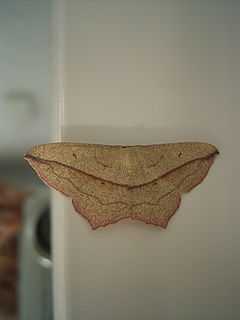Blood-vein
| Blood-vein | |
|---|---|
 | |
| Scientific classification | |
| Kingdom: | Animalia |
| Phylum: | Arthropoda |
| Class: | Insecta |
| Order: | Lepidoptera |
| Family: | Geometridae |
| Genus: | Timandra |
| Species: | T. comae |
| Binomial name | |
| Timandra comae (Schmidt, 1931) | |
The Blood-vein, (Timandra comae) is a moth of the family Geometridae. It has a scattered distribution in Western and Central Europe north of the Alps. In the British Isles the distribution is patchy outside southern England and Wales. In far eastern Europe – east of a line running roughly from Finland through Estonia –, it is replaced by its sister species Timandra griseata. The species were split in 1931, only to be subsequently re-merged by most authors. But since 1994, new research has come out in favour of treating them as distinct species.[1]
The wings are cream-coloured with bold red or purple fascia forming a diagonal stripe across forewings and hindwings. All wings are fringed with the same colour. The tornus of the hindwing is sharply angled giving a distinctive shape. The wingspan is 30–35 mm. Two broods are produced each year with the adults flying in May and June and again in August and September . It flies at night and is attracted to light.
The larva is grey-brown with darker spots on the back. In the UK, it feeds on the leaves of a variety of plants including dock, knotgrass, sorrel and various species of Atriplex. It overwinters as a larva.
- ^ The flight season refers to the British Isles. This varies in other parts of the range.
External links
| Wikimedia Commons has media related to Blood-vein. |
Bibliography
- Chinery, Michael (1986). Collins Guide to the Insects of Britain and Western Europe 1986 (Reprinted 1991)
- Õunap, Erki, Viidalepp Jaan and Saarma, Urmas (2005). Phylogenetic evaluation of the taxonomic status of Timandra griseata and T. comae (Lepidoptera: Geometridae: Sterrhinae). Eur. J. Entomol., 102:607-615. online
- Skinner, Bernard (1984) Colour Identification Guide to Moths of the British Isles 1984
References
- ↑ Õunap et al' (2005)